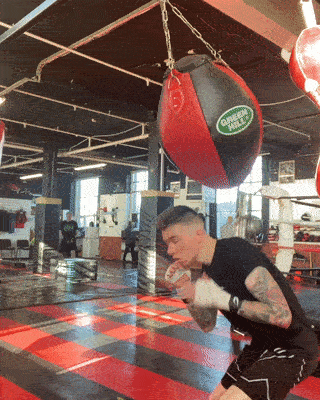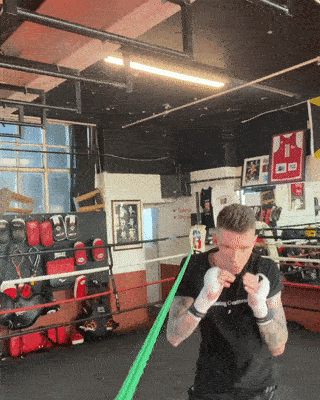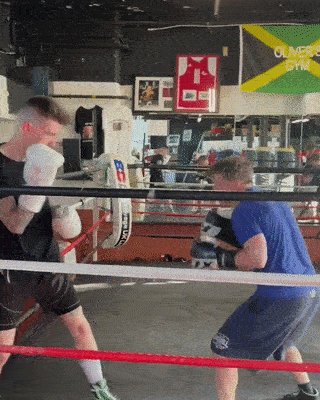6 Training Drills For Boxing Defence
"The best fighters hit the most and get hit the least," Rocky Marciano
Known as ‘The Sweet Science’, boxing is the art of hitting and not getting hit.
Many greats throughout history have mastered this in their illustrious careers and used their elite defensive abilities to reign as champions, including the likes of Willie Pep, Pernell Whitaker and Floyd Mayweather Jr.
Defence is one of the most important aspects of boxing, it keeps a fighter away from danger and helps set up more clinical attacking positions, while also increasing the chances of longevity in such a tough sport.
There are many various elements that make up a solid defence in the ring; reflexes, coordination, footwork, strong fundamentals and head movement.
BOXRAW outline six training drills that can be carried out to help enhance boxing defence.
Boxing Defence Drills
Wrecking Ball Bag

Upper body movement is an important factor in being able to make an opponent miss and subsequently make them pay in return. Having the ability to stand right in front of someone and still make them miss their punches is hugely frustrating and exhausting; using slips, rolls, blocks and parries to avoid shots up close, while staying in punching range.
The Drill: Stand directly in front of the wrecking ball bag in your boxing stance and give it a small push so it rocks back and forward. Practise your upper body and head movement in training by slipping out of the way (to both left and right) to avoid being hit and roll or duck under the incoming bag. Once you’ve found a rhythm and feel comfortable, start to throw some fast punches in between your boxing defence manoeuvres as well to get used to countering missed shots.
Floor To Ceiling Bag

You can’t get hurt or knocked out by punches that don’t land, making head movement vital in the ring. Your head should always be moving, not only when a punch is thrown in your direction. The best defensive fighters ever didn't just rely on reflexes but their constantly drilled movements too; so always make your head a moving target. This is a good way to develop how to block punches as well, as there is little force coming back at you.
The Drill: Stand in front of the floor to ceiling bag and begin by throwing single punches, such as a jab or back hand. Once connected, the bag will come back at your face so defensive moves must be added to avoid being hit. After throwing any shot at the bag, either slip, duck or even parry it with your hand to stop it from hitting you. Once you feel more confident, start throwing combinations and then moving out of the way with your defensive moves.
Slip Rope Shadowboxing

Moving your head before and after throwing shots can be the difference between winning and losing a fight. When your head is constantly off the punching line then an opponent will find it difficult to connect with a solid punch, making you more dangerous as you create openings for counters of your own.
The Drill: Connect a slip rope from one corner of the ring to the other and begin shadowboxing (hand wraps, skipping rope or long string can also be used and tied to different objects if at home). When in the position of the ring where the slip rope is, move under it by rolling and remember to keep your hands up when returning to your normal stance. Start to add in punches before and after rolling under the slip rope as you get used to the movements. This will also condition your legs for a fight scenario, as you continuously bend your knees while rolling under the rope in your defensive movements.
Octagon Ladder

Although it’s your hands that block punches, it’s your legs that are the most important component when it comes to defence. Your footwork gets you in and out of attacking positions, while carrying you throughout the duration of a fight. If your legs tire, you’re more likely to get hit, meaning conditioning is crucial. Also, being able to create angles and move away from opponents within the ring will help to keep you safe.
The Drill: While standing in your boxing stance, place your front foot inside the octagon ladder and keep your back foot to the outside. Keeping your front foot within the ladder, pivot either to your left or right while keeping your hands up. Also practise step-backs and lay-backs as defensive movements while your lead foot remains inside the ladder. These boxing moves improve your ability to defend punches on the inside and continues to condition your legs, as you're able to pivot a full 360 degrees.
Wall Bag

Using angles to move away from danger can lead to openings in an opponent’s guard and boost your chances of landing cleanly while avoiding shots. Great fighters such as Vasyl Lomachenko, Mike Tyson and James Toney used pivots to seamlessly turn defence into attack.
The Drill: Stand directly in front of the wall bag in your boxing stance and keep moving your head as if punches are being thrown at you. Once ready, when you slip or roll to your left, pivot on your lead foot while bringing your back foot in the same direction to your new position. When slipping or rolling to the right side, use your momentum to pivot on the ball of your lead foot and bring your back foot along in the same direction.
Technical Sparring

There’s no better way of developing and improving defence than actually sparring with another fighter. Not all sparring has to be intense and fought at a hard pace; taking the power levels down and working with each other helps to hone defensive skills for when it comes to stepping into the ring for a real fight.
The Drill: Find someone of a similar size and experience level to have a technical spar with, with the focus being more on defence and movement. After some rounds of getting used to punches being thrown at you, the intensity and pace can then be increased. Practise different defensive moves for certain punches coming at you and don’t get into the habit of repeating the same one each time, or else opponents will become aware of this over the course of a bout.
Hit and don’t get hit; that’s the name of the game. So, constantly drilling defence in training will have long-term benefits and boost your chances of earning success in the ring.
Drills: @gormleyy
